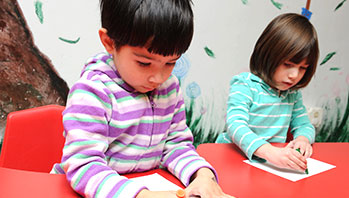- craft sticks or two-sided tape
- photocopies of story figures (3 houses, 3 javelinas, 1 coyote, tumbleweeds, cactus, girl with sticks, man with adobe bricks, stove with stovepipe)
- first
- last
- next
MA Standards:
English Language Arts/Literature/RL.PK.MA.2 With prompting and support, retell a sequence of events from a story read aloud.
English Language Arts/Literature/RL.PK.MA.3 With prompting and support, act out characters and events from a story or poem read aloud.
English Language Arts/Writing/W.PK.MA.3 Use a combination of dictating and drawing to tell a real or imagined story.
Head Start Outcomes:
Language Development/Expressive Language Engages in storytelling.
Literacy Knowledge/Book Appreciation and Knowledge Retells stories or information from books through conversation, artistic works, creative movement, or drama.
Literacy Knowledge/Early Writing Uses scribbles, shapes, pictures, and letters to represent objects, stories, experiences, or ideas.
PreK Learning Guidelines:
English Language Arts/Reading and Literature 10 Engage actively in read-aloud activities by asking questions, offering ideas, predicting or retelling important parts of a story or informational book.
Draw and Write Together: Retell The Three Little Javelinas

© Commonwealth of Massachusetts, Department of Early Education and Care (Jennifer Waddell photographer). All rights reserved.
ELA Focus Skills: Listening and Speaking, Recall and Retell, Story Comprehension, Vocabulary
Educator Prep: Make story character figures for retelling the story. Photocopy the characters from the book, cut them out, and laminate them. Then tape a craft stick onto the back to use as puppets, or place double-sided tape on the back so you can adhere the characters to the board while retelling.
Model how to retell the story with the story character figures. Have children sit in front of the board, or ask volunteers to be the different characters and give them each a puppet.
Place the story figures on the board from left to right—the direction we read words in a book. (Or, if children are playing the different characters, line them up from left to right.) Encourage children to help you tell what happens first, next, and last in the story. As children retell the story, write each line, in children’s words, at the bottom of a separate sheet of paper.
After retelling the whole story, ask children to illustrate each sheet of paper. Assemble the illustrations into a group book to display.
Place the story figures in the Play and Pretend Center for children to retell the story on their own.
English Language Learners: When role-playing or retelling a story, pair English language learners with strong English speakers who can pantomime to help explain any words or concepts.
Adaptation: Groups with an age range may wish to pair older and younger children so that older children can “guide” younger ones in how to make up dialogue.
